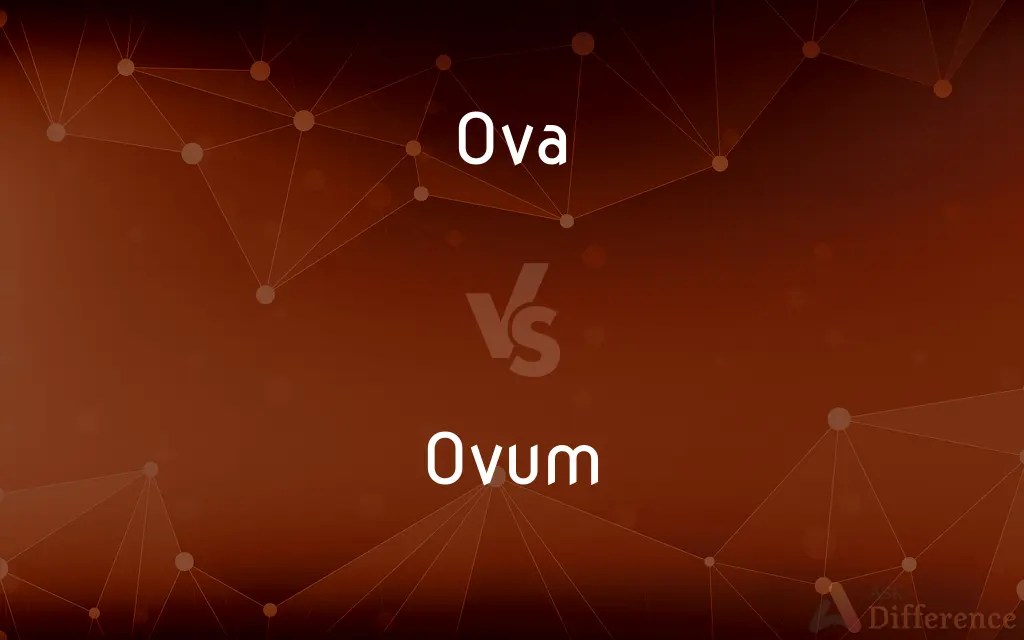Ova vs. Ovum — What's the Difference?
By Tayyaba Rehman & Urooj Arif — Updated on April 4, 2024
"Ova" are the plural form of "ovum," which refers to the female reproductive cells or eggs in animals and plants, while "ovum" denotes a single egg cell.

Difference Between Ova and Ovum
Table of Contents
ADVERTISEMENT
Key Differences
Ova and ovum, while closely related in the field of biology, serve to distinguish between the singular and plural forms of female reproductive cells. An ovum is a single egg cell, often considered the largest cell in the body of many organisms, including humans. It plays a crucial role in reproduction, carrying half of the genetic information required to form a new individual. On the other hand, ova refer to more than one ovum, indicating multiple egg cells.
The significance of an ovum extends beyond its size; it represents the female contribution to the genetic makeup of the offspring, providing not only half of the chromosomes but also the cellular structures necessary for the initial stages of development. In contrast, the term ova encompasses the collective potential for fertility and reproduction within an organism, highlighting the multiplicity of opportunities for fertilization and subsequent development.
In medical and scientific contexts, the distinction between ovum and ova is essential for clarity and precision. For example, when discussing fertilization, one might refer to a single ovum being fertilized by a sperm cell. In studies or discussions about the overall fertility or egg production of an organism, however, the term ova would be more appropriate, as it implies the presence and consideration of multiple eggs.
Furthermore, the development and maturation of an ovum, and by extension ova, are subjects of significant interest and research within both the medical field and evolutionary biology. Understanding how an ovum matures, its journey through the reproductive tract, and the conditions under which it can become fertilized provides valuable insights into fertility, reproductive health, and the complex interplay of hormonal and cellular mechanisms.
The usage of ovum and ova also extends into broader discussions about reproductive rights, fertility treatments, and the ethical considerations surrounding assisted reproductive technologies. In such debates, distinguishing between the potential held within a single ovum versus the collective potential of ova can shape perspectives, policies, and personal decisions regarding reproduction.
ADVERTISEMENT
Comparison Chart
Definition
A single female reproductive cell or egg.
The plural form of ovum, referring to multiple egg cells.
Role in Reproduction
Carries half of the genetic information for a new individual.
Represent the collective fertility potential in organisms.
Context of Use
Refers to individual eggs in scientific and medical discussions.
Used when discussing multiple eggs or general fertility.
Significance
Largest cell in many organisms, crucial for reproduction.
Highlight the multiplicity of reproductive opportunities.
Related Research
Focuses on the maturation, journey, and fertilization conditions of single eggs.
May involve studies on fertility rates and egg production.
Compare with Definitions
Ova
Critical in studies of fertilization and early development.
Research on ovum health impacts understandings of fertility and pregnancy.
Ovum
Plural of ovum, referring to female reproductive cells.
Ova are produced and matured in the ovaries of females.
Ova
The female gamete or egg cell in animals and plants.
The ovum is fertilized by a sperm cell to form a zygote.
Ovum
In vitro fertilization (IVF) often involves the collection of multiple ova.
Multiple ova are harvested to increase the chances of successful fertilization in IVF procedures.
Ova
Essential for reproduction, carrying half the genetic material.
Each ovum contains 23 chromosomes in humans, ready to combine with those from the sperm.
Ovum
The handling and use of ova in fertility treatments spark debates.
The donation and freezing of ova pose ethical considerations regarding consent and future use.
Ova
Undergoes a process of maturation before it is ready to be fertilized.
The ovum matures within the ovary and is released during ovulation.
Ovum
Often mentioned in the context of overall reproductive potential.
The number of ova a female has can impact her fertility.
Ova
Central to discussions on assisted reproductive technologies.
The use of donor ova raises important ethical and legal questions.
Ovum
Studies often explore the production, health, and viability of ova.
Advances in preserving ova have significant implications for fertility treatments.
Ova
Plural of ovum.
Ovum
The mature female gamete of an animal; an egg.
Ova
Qualifier|scientific term}} {{plural of ovum
Ovum
(cytology) The female gamete in animals; the egg cell.
Ova
See Ovum.
Ovum
A more or less spherical and transparent cell, which by a process of multiplication and growth develops into a mass of cells, constituting a new individual like the parent; an egg, spore, germ, or germ cell. See Illust. of Mycropyle.
Ovum
One of the series of egg-shaped ornaments into which the ovolo is often carved.
Ovum
The female reproductive cell; the female gamete
Common Curiosities
Why is the distinction between ovum and ova important?
The distinction clarifies whether one is referring to a single egg cell or multiple, which is crucial in scientific accuracy and communication.
What are ova?
Ova are the plural form of ovum, referring to multiple egg cells within an organism.
Can ova be preserved for future use?
Yes, through cryopreservation, ova can be frozen and stored for future fertility treatments.
What factors affect the health of an ovum?
Factors include age, hormonal balance, environmental influences, and overall health.
How are ova used in fertility treatments?
In treatments like IVF, ova are collected, fertilized in a lab, and the resulting embryos are transferred to the uterus.
What is an ovum?
An ovum is a single egg cell involved in reproduction, carrying half of the genetic information needed to form a new individual.
How does an ovum become fertilized?
An ovum becomes fertilized when a sperm cell successfully penetrates it, leading to the combination of their genetic materials.
How does ovum maturation impact fertility?
The process of ovum maturation and its timing are critical for successful fertilization and pregnancy.
What ethical considerations arise with ovum donation?
Considerations include consent, anonymity of donors, and the rights of children born from donated ova.
What research is being done on ova?
Research focuses on understanding ovum development, improving fertility treatments, and preserving reproductive health.
Share Your Discovery

Previous Comparison
Domitable vs. Indomitable
Next Comparison
Horsepower vs. ManpowerAuthor Spotlight
Written by
Tayyaba RehmanTayyaba Rehman is a distinguished writer, currently serving as a primary contributor to askdifference.com. As a researcher in semantics and etymology, Tayyaba's passion for the complexity of languages and their distinctions has found a perfect home on the platform. Tayyaba delves into the intricacies of language, distinguishing between commonly confused words and phrases, thereby providing clarity for readers worldwide.
Co-written by
Urooj ArifUrooj is a skilled content writer at Ask Difference, known for her exceptional ability to simplify complex topics into engaging and informative content. With a passion for research and a flair for clear, concise writing, she consistently delivers articles that resonate with our diverse audience.














































